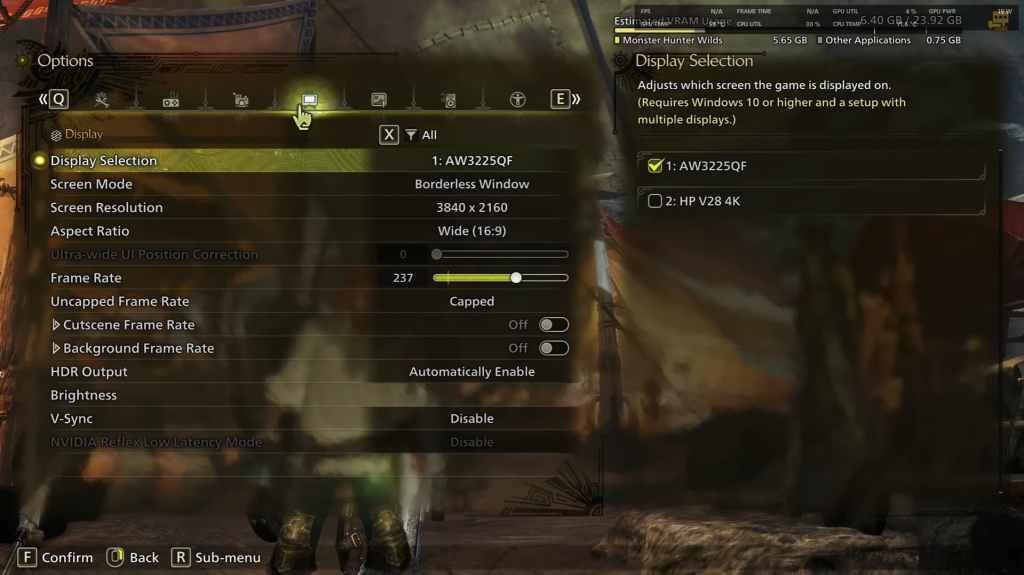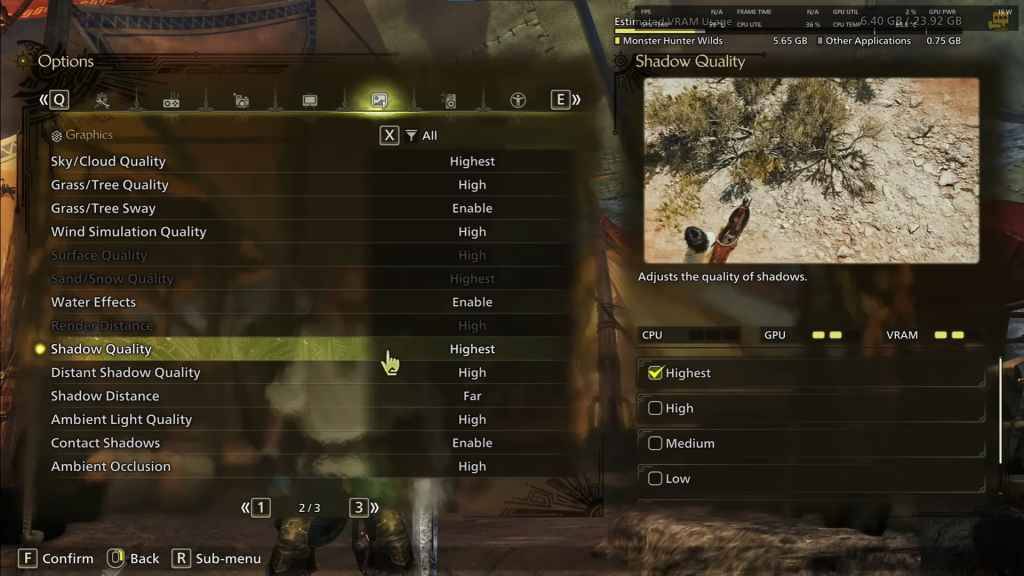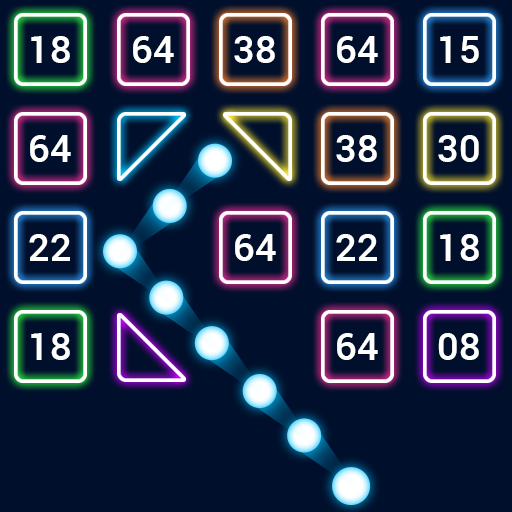Best Graphics Settings in Monster Hunter Wilds
Monster Hunter Wilds boasts stunning visuals, but achieving optimal performance while retaining visual fidelity requires careful graphics setting adjustments. This guide outlines the best settings for various PC builds.
Recommended Videos: Monster Hunter Wilds System Requirements
High resolutions and maximum settings demand a high-end GPU with ample VRAM and a powerful CPU. Find out where to purchase Monster Hunter Wilds for your preferred platform.
| Minimum Requirements | Recommended Requirements |
| OS: Windows 10 or newer CPU: Intel Core i5-10600 / AMD Ryzen 5 3600 Memory: 16GB RAM GPU: NVIDIA GTX 1660 Super / AMD Radeon RX 5600 XT (6GB VRAM) DirectX: Version 12 Storage: 140GB SSD required Performance Expectation: 30 FPS @ 1080p (upscaled from 720p) | OS: Windows 10 or newer CPU: Intel Core i5-11600K / AMD Ryzen 5 3600X Memory: 16GB RAM GPU: NVIDIA RTX 2070 Super / AMD RX 6700XT (8-12GB VRAM) DirectX: Version 12 Storage: 140GB SSD required Performance Expectation: 60 FPS @ 1080p (Frame Generation enabled) |
Best Graphics Settings for Monster Hunter Wilds
Optimizing Monster Hunter Wilds graphics settings is crucial, regardless of your hardware. Significant performance gains are achievable without compromising visual quality substantially. The difference between Ultra and High settings is often negligible visually, but the performance impact is considerable.
Display Settings

Screen Mode: Personal preference; Bordered Fullscreen offers better performance when tabbing out frequently. Resolution: Your monitor's native resolution. Frame Rate: Match your monitor's refresh rate (e.g., 144Hz, 240Hz). V-Sync: Off for reduced input lag. Related: How Long Is Monster Hunter Wilds?
Graphics Settings

| Setting | Recommended | Description |
| Sky/Cloud Quality | Highest | Enhances atmospheric detail. |
| Grass/Tree Quality | High | Affects vegetation detail. |
| Grass/Tree Sway | Enabled | Adds realism, minor performance impact. |
| Wind Simulation Quality | High | Improves environmental effects. |
| Surface Quality | High | Details on the ground and objects. |
| Sand/Snow Quality | Highest | Detailed terrain textures. |
| Water Effects | Enabled | Adds reflections and realism. |
| Render Distance | High | Determines how far objects are rendered. |
| Shadow Quality | Highest | Improved lighting, demanding setting. |
| Distant Shadow Quality | High | Enhances shadow detail at a distance. |
| Shadow Distance | Far | Controls how far shadows extend. |
| Ambient Light Quality | High | Enhances shadow detail at a distance. |
| Contact Shadows | Enabled | Enhances small object shadowing. |
| Ambient Occlusion | High | Improves depth in shadows. |
These settings prioritize visual fidelity over raw FPS. Since Monster Hunter Wilds isn't a competitive game, sacrificing visuals for minor FPS gains diminishes the overall experience. However, adjust these settings based on your specific hardware.
To boost performance, reduce Shadows and Ambient Occlusion first, as they are the most resource-intensive. Lowering Distant Shadows, Shadow Distance, Water Effects, and Sand/Snow Quality also provides significant FPS improvements.
Best Settings for Different Builds
The following recommendations cater to various hardware configurations. Settings not explicitly mentioned should remain at their defaults.
Mid-Range Build (GTX 1660 Super / RX 5600 XT)
Resolution: 1080p Upscaling: AMD FSR 3.1 Balanced Frame Gen: Off Textures: Low Render Distance: Medium Shadow Quality: Medium Distant Shadow Quality: Low Grass/Tree Quality: Medium Wind Simulation: Low Ambient Occlusion: Medium Motion Blur: Off V-Sync: Off Expected Performance: ~40-50 FPS at 1080p
Recommended Build (RTX 2070 Super / RX 6700XT)
Resolution: 1080p Upscaling: FSR 3.1 Balanced Frame Gen: Enabled Textures: Medium Render Distance: Medium Shadow Quality: High Distant Shadow Quality: Low Grass/Tree Quality: High Wind Simulation: High Ambient Occlusion: Medium Motion Blur: Off V-Sync: Off Expected Performance: ~60 FPS at 1080p
High-End Build (RTX 4080 / RX 7900 XTX)
Resolution: 4K Upscaling: DLSS 3.7 Performance (NVIDIA) / FSR 3.1 (AMD) Frame Gen: Enabled Textures: High Render Distance: Highest Shadow Quality: High Distant Shadow Quality: High Grass/Tree Quality: High Wind Simulation: High Ambient Occlusion: High Motion Blur: Off V-Sync: Off Expected Performance: ~90-120 FPS at 4K (upscaled)
Monster Hunter Wilds offers extensive graphical options, but their impact on gameplay varies. For performance issues, prioritize reducing shadows, ambient occlusion, and render distance. Budget users should leverage FSR 3 upscaling, while high-end systems can utilize frame generation at 4K. A balanced approach involves a mix of medium-high settings, upscaling, and adjusting shadow/distance settings based on your hardware.
Monster Hunter Wilds is available now on PlayStation, Xbox, and PC.
- 1 Silent Hill 2 Remake Confirms Xbox, Switch Release in 2025 Feb 08,2025
- 2 Connect Asus ROG Ally to TV or Monitor: Easy Guide Apr 06,2025
- 3 Dragon Soul Tier List: Ultimate Guide May 12,2025
- 4 "Persona Games and Spin-Offs: Complete Chronological List" Apr 09,2025
- 5 Assassin's Creed Shadows: Max Level and Rank Cap Revealed Mar 27,2025
- 6 The Best Marvel Contest of Champions Tier List for 2025 Mar 19,2025
- 7 "Discover All Templar Locations in Assassin’s Creed Shadows - Spoiler Guide" Apr 04,2025
- 8 Basketball Zero: Official Trello and Discord Links Revealed Mar 26,2025
-
Top Arcade Classics and New Hits
A total of 10
-
Addictive Arcade Games for Mobile
A total of 10
-
Android Apps for Video Content Creation
A total of 10










![Roblox Forsaken Characters Tier List [UPDATED] (2025)](https://img.actcv.com/uploads/18/17380116246797f3e8a8a39.jpg)

















